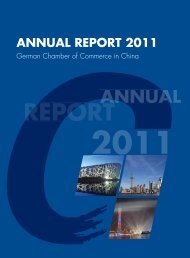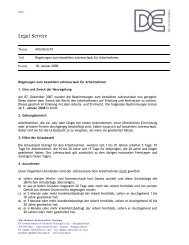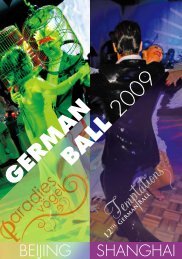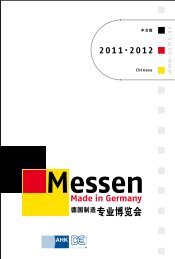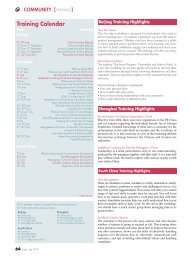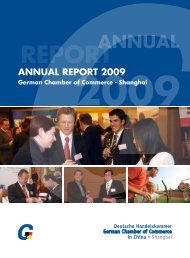Minister Steinmeier - AHKs
Minister Steinmeier - AHKs
Minister Steinmeier - AHKs
You also want an ePaper? Increase the reach of your titles
YUMPU automatically turns print PDFs into web optimized ePapers that Google loves.
The German Chamber of Commerce in China<br />
Small Town Feel with Big City Plans<br />
Changzhou<br />
Changzhou’s advantageous location right between Shanghai and<br />
Nanjing has clearly aided its development. Nicknamed the ‘Dragon<br />
City,’ Changzhou has a track record of flourishing during trying times<br />
in Chinese history. It benefited from the Taiping Rebellion, which<br />
constructed some of the city’s premier temples and pagodas. In the<br />
1930s, the Japanese occupation of Shanghai caused many businesses<br />
to relocate, resulting in Changzhou importing the entire Shanghai<br />
cotton and textile industry. Additionally, the city emerged successful<br />
from the period of the Cultural Revolution while cities such as Shanghai<br />
were struggling economically.<br />
With a population of 3.4m, Changzhou is certainly dwarfed by other<br />
emerging cities such as Nanjing or Hangzhou. However, it makes up<br />
the difference with its progressive policies. The Changzhou government<br />
acts to promote a more environmentally-friendly development,<br />
as evidenced by the closure or relocation of several polluting factories<br />
in recent years. Furthermore, the city ensures that 99% of its schoolage<br />
residents attend high school. Many continue onto institutions of<br />
higher education, which have healthy graduation rates.<br />
Attractive Environment<br />
Due to positive developments in the areas of environmental protection<br />
and human resources, many companies have chosen Changzhou<br />
as a strategic base along the Yangtze River. The local airport, Grand<br />
Canal, river network and highway network all make the surrounding<br />
areas, including Nanjing and Shanghai, accessible within an hour or<br />
two. Currently, 20,000 manufacturing companies have set up shop in<br />
Changzhou, including 42 international giants from the West and Asia.<br />
The Path from Agriculture to Textiles to<br />
Engineering<br />
Formerly, Changzhou was a center for the distribution of local agricultural<br />
products. However, while food processing and distribution are<br />
still prevalent, the share of traditional agricultural output has shrunk<br />
to less than 6% of the local economy. The textile industry, spurred by<br />
the influx of cotton processing in the 1930s, continues to churn along<br />
strongly.<br />
East China - Changzhou<br />
In the manufacturing sector, Changzhou excels in power generation<br />
due to its access to hydropower. Automotive and motorcycle production<br />
are also successful, and electronics and engineering machinery<br />
have made their mark. Diesel engines are one of their top manufacturing<br />
products.<br />
Service Sector Blossoms at Changzhou National<br />
Hi-Tech District<br />
New high tech industries have also landed in Changzhou, and now<br />
constitute 50% of the local economy, as evidenced by the Changzhou<br />
National Hi-Tech District. Since 1992, the CND has filled 20km 2 of its<br />
total 30km 2 area with 7636 companies, 18 of which rank as Fortune<br />
500. Located north of the city, the CND offers access to an oceangoing<br />
port for easy export of goods bound for Shanghai or overseas.<br />
The CND includes four subsections:<br />
• Start-up Hi-Tech Park: electronics, pharmaceuticals, biotech, mechatronics<br />
• Industrial Park: machinery, plastics, chemicals, electronics<br />
• Commercial & Residential Park: service arm of the CND, including<br />
educational facilities and residences<br />
• Tourist Park: Dinosaur Park, expat club and health clubs<br />
Tourism Initiative Set to Bring in Visitors<br />
While promoting its history for the purposes of tourism, Changzhou<br />
also welcomes fresh ideas to boost the number of visitors. From the<br />
scenic Tianmu Lake to the new Dinosaur Park, visitors can expect quite<br />
a variety.<br />
The Tianning Temple, built over 1350 years ago during the Tang<br />
Dynasty, is one of Changzhou’s historically significant sites. It is also<br />
known as the “Famous Spot of the Three Wu.” Destroyed and rebuilt<br />
5 times, the Tianning Temple covers 6.7 hectares and houses over 70<br />
monks, known for their strict interpretation of Buddhism. The Tianning<br />
Pagoda is the tallest in China, and perhaps the tallest in the world, at<br />
153m.<br />
The location of the temple is significant to the Buddhist religion,<br />
located in the middle of the 5 directions: east (Lingshan), west<br />
(Leshan), south (Hong Kong), north (Yuyuan) and center (Langmen),<br />
where 5 other Grand Buddhas may be found.<br />
The ruins of the former King’s Palace built during the Taiping rebellion<br />
are also of note and can be seen near the city center. The palace was<br />
one of 5 palaces built during the tumultuous era.<br />
Tianmu Lake, not far away, offers scenic repose from city life. The lake<br />
which is named “Heavenly Eyes” in Chinese, is shaped in two round<br />
circles. Visitors come to try the local delicacy fish head soup, hike and<br />
boat.<br />
Perhaps one of Changzhou’s most talked-about recent tourism developments<br />
is the Changzhou China Dinosaur park, sometimes referred to as<br />
“Oriental Jurassic Park.” The attraction contains fossils from all across<br />
China, some reconstructed into complete skeletons. The facility offers<br />
multimedia educational displays, and each room attempts to recreate<br />
a different scene from prehistoric times.<br />
www.china.ahk.de 17 | August - September 2008<br />
Business Focus




